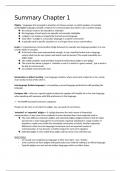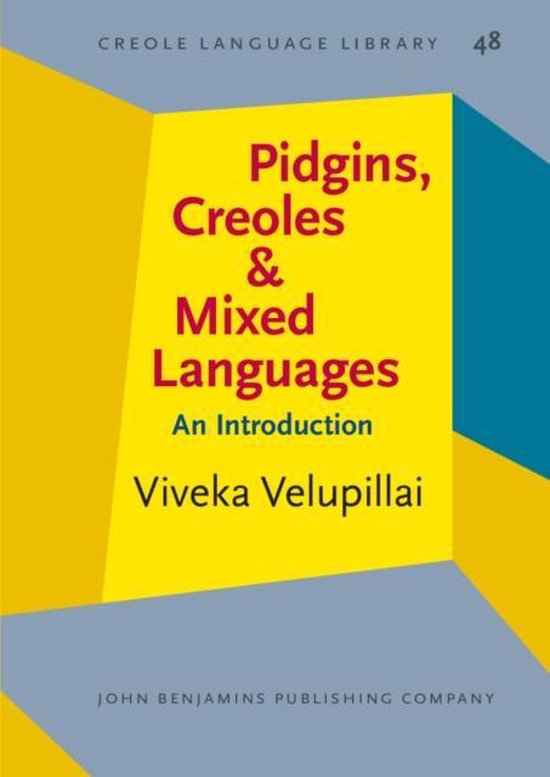Summary Chapter 1
Pidgins = languages that emerged in situations of intense contact, in which speakers of mutually
unintelligible languages needed a medium for communication but which is not a mother tongue.
the contact needs to be repeated or extended
the languages of each party are typically not mutually intelligible
a pidgin is not simply an imperfectly learned second language
most often “a pidgin is a secondary language in a speech community”
is typically used in specific situations or as a lingua franca across communities.
jargon = A spontaneous communicative bridge between for example two language speakers in a new
country while on vacation.
If this tool is then used systematically enough, it may crystallize further into a language
variety which has its own system and which must be learned. This would essentially be a
pidgin stage
also called unstable/ early/primitive/incipient/rudimentary pidgin or pre-pidgin
The crucial fact about a jargon is “whether or not it is useful in a given context”, just a need to
be able to communicate.
an unstable communicative tool
koineization or dialect levelling = two language varieties, where each party makes his or her variety
more similar to that of the other’s.
Interlanguage (broken language) = not speaking a second language perfectly but still speaking the
language.
Foreigner talk = refers to a special register4 where the speaker will simplify his or her own language
when speaking with someone with little proficiency in that language.
!! – No SHARP boundaries between categories
People can be more or less fluent in pidgin, you can speak of correctness.
‘extended’ or ‘expanded’ pidgins = If a pidgin becomes the main means of interethnic
communication, it may come to be employed in more domains than it was originally used in.
The main difference between pidgins and extended pidgins (pidgincreoles) is that the latter
has become a main language for its community, regularly employed in a large number of
situations, maybe even within the immediate community or family. Another important
difference is that once the language has become such an important means of
communication, it may become a mother tongue for some of its speakers.
Extended pidgin is more stable than pidgin and has more of an unlimited use.
Social status:
- are usually not recognized as languages in their own right – lazy / broken
- some countries do have pidgins with good status even without making it an official language.
- Typically pidgins are oral and not written languages which can effect status.
,Origin word pidgin:
- A LOT of theories
- Best accepted theory = ‘pidgin’ derives from the Chinese Pidgin English pronunciation of
business
- It is not unlikely that ‘pidgin’ has its origin in a number of different sources
Types of pidgins:
1. Trade and nautical pidgins
a. Maritime/nautical pidgins
b. Trade pidgins
2. Workforce pidgins
a. Domestic workforce pidgins
b. Plantation pidgins
c. Mine and industry pidgins
3. Military pidgins
4. Urban pidgins
Assumed typical pidgin features:
- Phonology: fewer phonemes than input languages, five vowels and simpler syllable structure.
Typically lack of tone contrasts.
- Morphology: few/no inflections, few/no derivational morphology, mostly analytic, mostly
free morphemes, most of time no reduplication, no allomorph or agreement.
- Noun phrase: lack case, gender, number, definite/indefinite articles
- Verb phrase: lack tense marking, use of context or adverbials for time.
- Simple sentences: fixed word order, same structure sentences/questions with only difference
in intonation, question words have two morphemes, use of negator present, no passive
sentences.
- Predication: lack of copula = verb like ‘is’ between the house and red to say the house is red.
- Complex sentences: lack of complex sentences and combining clauses
- Lexicon: mainly derived from one language, words are short, less compounds, has
multifunctional words, few/no synonyms, words are more general, fewer function words.
, Summary Chapter 2
Creole = a natural language spoken as a mother tongue by an entire community that arose due to
situations of intense contact.
Just like any other language, every situation can be talked about, thought about and
conducted in any given creole language.
Some argue that creoles can be identified by the linguistic structure that they have, i.e. that they form
a special type of language. Others argue that there is no (or not enough) evidence for the claim that
creoles form a distinct typological class and that the motivation for treating some languages as
creoles lies in the sociohistorical settings in which they emerged.
the fact that creole languages are fully adequate natural languages that may serve any and
all linguistic needs of the speakers is not questioned by any serious linguist.
The etymology for ‘creole’ is less opaque than that for pidgin:
- first, term creole referred to Europeans born in Colonies.
- First Portuguese word, French took over, and English took over French term
- Gradually ‘creole’ was being used to refer to the culture(s) and language(s) of the population
in the Colonies.
- The first known use of ‘creole’ to refer to a language is from a travel account by the
Portuguese Francisco de Lemos Coelho in 1684 (the “creoulo de Cacheu)
- The first known English use of ‘creole’ to refer to a language is from 1726; the passages in
question refer to the Cape Verde Islands
The social status of creole languages:
The vast majority of languages that we know as creoles today have suffered a long history of
condescension and stigmatization, a situation which is far from over today. The languages have been
viewed as “broken”, “lazy”, “debased”, or in other ways highly inadequate versions of their European
lexifiers.
Such attitudes have made many creole speakers regard their own language as backwards or
inferior, leading many to deny the fact that they have a creole language as a mother tongue.
Diglossia = when speakers use specific language varieties in specific situations, typically using the
creole in familiar or informal situations while using the officially recognized language(s) in official or
formal situations
Example disglossia:
Ambon Malay, has been spoken on the island of Ambon (Indonesia) for many centuries and has
about 200,000 mother tongue speakers, and is also used as a lingua franca by as many as a million
speakers on the central and southern Maluku Islands. However, the speakers of Ambon Malay “often
view it as an inferior variety of Indonesian”. The two languages stand in a diglossic relationship to
each other, with Indonesian used in formal settings (government administration, media, education,
etc.) and Ambon Malay used at home or in informal interaction in the community.





